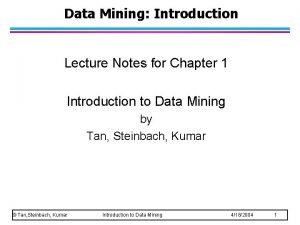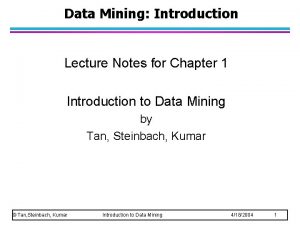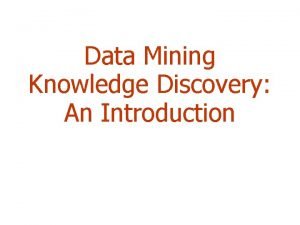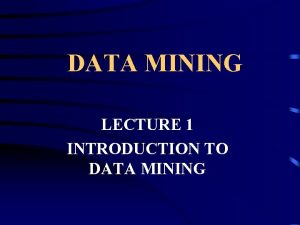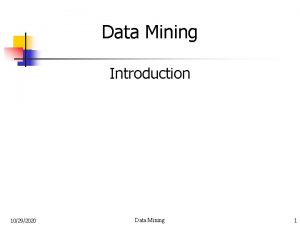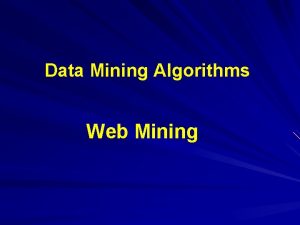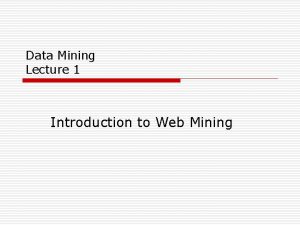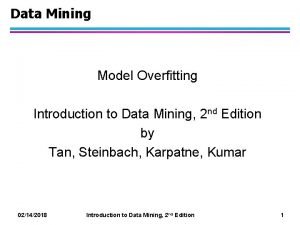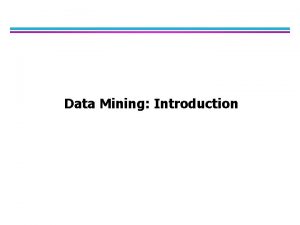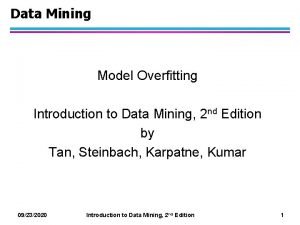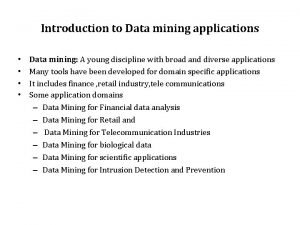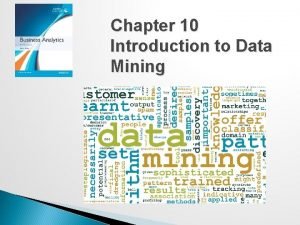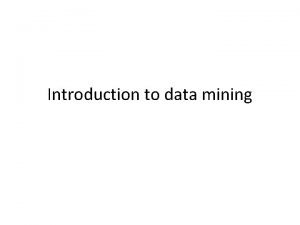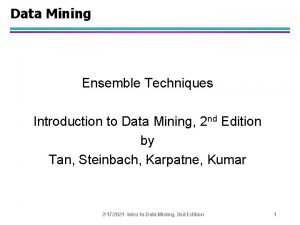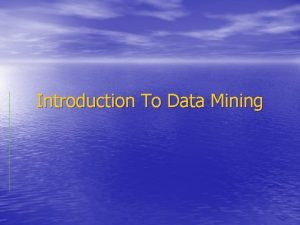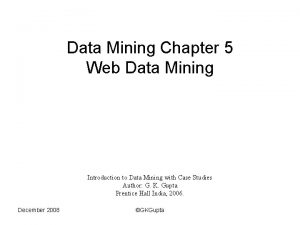DATA MINING LECTURE 1 INTRODUCTION TO DATA MINING


































- Slides: 34

DATA MINING LECTURE 1 INTRODUCTION TO DATA MINING

Why Data Mining? • The Explosive Growth of Data: from terabytes to petabytes – Data collection and data availability • Automated data collection tools, database systems, Web, computerized society – Major sources of abundant data • Business: Web, e-commerce, transactions, stocks, … • Science: Remote sensing, bioinformatics, scientific simulation, … • Society and everyone: news, digital cameras, You. Tube • We are drowning in data, but starving for knowledge! • Data mining— Automated analysis of massive data sets

Introduction • Data is growing at a phenomenal rate • Users expect more sophisticated information • How? UNCOVER HIDDEN INFORMATION DATA MINING VESIT M. VIJAYALAKSHMI 3

Data Mining Definition • Finding hidden information in a huge store of data • Fit data to a model • Similar terms – Exploratory data analysis – Data driven discovery – Deductive learning DATA MINING VESIT M. VIJAYALAKSHMI 4

What Is Data Mining? • Data mining (knowledge discovery in databases): – Extraction of interesting (non-trivial, implicit, previously unknown and potentially useful) information or patterns from data in large databases • Alternative names – Knowledge discovery(mining) in databases (KDD), knowledge extraction, data/pattern analysis, data archeology, data dredging, information harvesting, business intelligence, etc. • What is not data mining? – (Deductive) query processing. – Expert systems or small ML/statistical programs DATA MINING VESIT M. VIJAYALAKSHMI 5

Potential Applications • Market analysis and management – target marketing, CRM, market basket analysis, cross selling, market segmentation • Risk analysis and management – Forecasting, customer retention, quality control, competitive analysis • Fraud detection and management • Text mining (news group, email, documents) and Web analysis. – Intelligent query answering DATA MINING VESIT M. VIJAYALAKSHMI 6

Market Analysis and Management (1) • Where are the data sources for analysis? – Credit card transactions, loyalty cards, discount coupons, customer complaint calls, – Target marketing (Find clusters of “model” customers who share the same characteristics: interest, income level, spending habits, etc. ) • Determine customer purchasing patterns over time • Cross-market analysis – Associations/co-relations between product sales – Prediction based on the association information DATA MINING VESIT M. VIJAYALAKSHMI 7

Market Analysis and Management (2) • Customer profiling – data mining can tell you what types of customers buy what products (clustering or classification) • Identifying customer requirements – identifying the best products for different customers – use prediction to find what factors will attract new customers • Provides summary information – various multidimensional summary reports – statistical summary information (data central tendency and variation) DATA MINING VESIT M. VIJAYALAKSHMI 8

Fraud Detection and Management • Applications – widely used in health care, retail, credit card services, telecommunications (phone card fraud), etc. • Approach – use historical data to build models of fraudulent behavior and use data mining to help identify similar instances • Examples – auto insurance: detect a group of people who stage accidents to collect on insurance – money laundering: detect suspicious money transactions (US Treasury's Financial Crimes Enforcement Network) – medical insurance: detect professional patients and ring of doctors and ring of references DATA MINING VESIT M. VIJAYALAKSHMI 9

Data Mining vs. KDD • Knowledge Discovery in Databases (KDD): process of finding useful information and patterns in data. • Data Mining: Use of algorithms to extract the information and patterns derived by the KDD process. DATA MINING VESIT M. VIJAYALAKSHMI 10

KDD Process: Several Key Steps • Learning the application domain – relevant prior knowledge and goals of application • Creating a target data set: data selection • Data cleaning and preprocessing: (may take 60% of effort!) • Data reduction and transformation – Find useful features, dimensionality/variable reduction, invariant representation • Choosing functions of data mining – summarization, classification, regression, association, clustering • Choosing the mining algorithm(s) • Data mining: search for patterns of interest • Pattern evaluation and knowledge presentation • Use of discovered knowledge

Knowledge Discovery (KDD) Process – Data mining—core of knowledge discovery process Pattern Evaluation Data Mining Task-relevant Data Warehouse Data Cleaning Data Integration Databases Selection

Data Mining and Business Intelligence Increasing potential to support business decisions Making Decisions Data Presentation Visualization Techniques Data Mining Information Discovery End User Business Analyst Data Exploration Statistical Analysis, Querying and Reporting Data Warehouses / Data Marts OLAP, MDA Data Sources Paper, Files, Information Providers, Database Systems, OLTP DATA MINING VESIT M. VIJAYALAKSHMI DBA 13

Data Mining: Confluence of Multiple Disciplines Database Technology Machine Learning Statistics Data Mining Information Science DATA MINING VESIT M. VIJAYALAKSHMI Visualization Other Disciplines 14

Data Mining Development • Relational Data Model • SQL • Association Rule Algorithms • Data Warehousing • Scalability Techniques • Algorithm Design Techniques • Algorithm Analysis • Data Structures • Similarity Measures • Hierarchical Clustering • IR Systems • Imprecise Queries • Textual Data • Web Search Engines • Bayes Theorem • Regression Analysis • EM Algorithm • K-Means Clustering • Time Series Analysis • Neural Networks • Decision Tree Algorithms DATA MINING VESIT M. VIJAYALAKSHMI 15

Data Mining Functionalities • Multidimensional concept description: Characterization and discrimination – Generalize, summarize, and contrast data characteristics, e. g. , dry vs. wet regions • Frequent patterns, association, correlation vs. causality – Milk Fruit [0. 5%, 75%] (Correlation or causality? ) • Classification and prediction – Construct models (functions) that describe and distinguish classes or concepts for future prediction • E. g. , classify countries based on (climate), or classify cars based on (gas mileage) – Predict some unknown or missing numerical values

Data Mining Functionalities (2) • Cluster analysis – Class label is unknown: Group data to form new classes, e. g. , cluster houses to find distribution patterns – Maximizing intra-class similarity & minimizing interclass similarity • Outlier analysis – Outlier: Data object that does not comply with the general behavior of the data – Noise or exception? - fraud detection, rare events analysis • Trend and evolution analysis – Trend and deviation: e. g. , regression analysis – Sequential pattern mining: digital camera large SD Mem. – Periodicity analysis – Similarity-based analysis • Other pattern-directed or statistical analyses

Data Mining Issues • • Human Interaction Overfitting Outliers Interpretation Visualization Large Datasets High Dimensionality DATA MINING VESIT M. VIJAYALAKSHMI • • Multimedia Data Missing Data Irrelevant Data Noisy Data Changing Data Integration Application 18

Major Issues in Data Mining (1) • Mining methodology and user interaction – Mining different kinds of knowledge in databases – Interactive mining of knowledge at multiple levels of abstraction – Incorporation of background knowledge – Data mining query languages and ad-hoc data mining – Expression and visualization of data mining results – Handling noise and incomplete data – Pattern evaluation: the interestingness problem • Performance and scalability – Efficiency and scalability of data mining algorithms – Parallel, distributed and incremental mining methods DATA MINING VESIT M. VIJAYALAKSHMI 19

Major Issues in Data Mining (2) • Issues relating to the diversity of data types – Handling relational and complex types of data – Mining information from heterogeneous databases and global information systems (WWW) • Issues related to applications and social impacts – Application of discovered knowledge • Domain-specific data mining tools • Intelligent query answering • Process control and decision making – Integration of the discovered knowledge with existing knowledge: A knowledge fusion problem – Protection of data security, integrity, and privacy DATA MINING VESIT M. VIJAYALAKSHMI 20

Social Implications of DM • Privacy • Profiling • Unauthorized use DATA MINING VESIT M. VIJAYALAKSHMI 21

Data Mining Metrics • • Usefulness Return on Investment (ROI) Accuracy Space/Time DATA MINING VESIT M. VIJAYALAKSHMI 22

Are All the “Discovered” Patterns Interesting? • Data mining may generate thousands of patterns: – Human-centered, query-based, focused mining • Interestingness measures – A pattern is interesting if it is easily understood by humans, valid on new or test data with some degree of certainty, potentially useful, novel, or validates some hypothesis that a user seeks to confirm • Objective vs. subjective interestingness measures – Objective: based on statistics and structures of patterns, e. g. , support, confidence, etc. – Subjective: based on user’s belief in the data, e. g. , unexpectedness, novelty, actionability, etc.

Find All and Only Interesting Patterns? • Find all the interesting patterns: Completeness – Can a data mining system find all the interesting patterns? Do we need to find all of the interesting patterns? – Heuristic vs. exhaustive search – Association vs. classification vs. clustering • Search for only interesting patterns: An optimization problem – Can a data mining system find only the interesting patterns? • First general all the patterns and then filter out the uninteresting ones • Generate only the interesting patterns—mining query optimization

Why Data Mining Query Language? • Automated vs. query-driven? – Finding all the patterns autonomously in a database? — unrealistic because the patterns could be too many but uninteresting • Data mining should be an interactive process – User directs what to be mined • Users must be provided with a set of primitives to be used to communicate with the data mining system • Incorporating these primitives in a data mining query language – More flexible user interaction – Foundation for design of graphical user interface – Standardization of data mining industry and practice

Primitives that Define a Data Mining Task • 1. Task-relevant data – – – Database or data warehouse name Database tables or data warehouse cubes Condition for data selection Relevant attributes or dimensions Data grouping criteria • 2. Type of knowledge to be mined – Characterization, discrimination, association, classification, prediction, clustering, outlier analysis, other data mining tasks • Background knowledge • Pattern interestingness measurements • Visualization/presentation of discovered patterns

Primitive 3: Background Knowledge • A typical kind of background knowledge: Concept hierarchies • Schema hierarchy – E. g. , street < city < province_or_state < country • Set-grouping hierarchy – E. g. , {20 -39} = young, {40 -59} = middle_aged • Operation-derived hierarchy – email address: hagonzal@cs. uiuc. edu login-name < department < university < country • Rule-based hierarchy – low_profit_margin (X) <= price(X, P 1) and cost (X, P 2) and (P 1 - P 2) < $50

Primitive 4: Pattern Interestingness Measure • Simplicity e. g. , (association) rule length, (decision) tree size • Certainty e. g. , confidence, P(A|B) = #(A and B)/ #(B), classification reliability or accuracy, certainty factor, rule strength, rule quality, discriminating weight, etc. • Utility potential usefulness, e. g. , support (association), noise threshold (description) • Novelty not previously known, surprising (used to remove redundant rules, e. g. , Illinois vs. Champaign rule implication support ratio)

Primitive 5: Presentation of Discovered Patterns • Different backgrounds/usages may require different forms of representation – E. g. , rules, tables, crosstabs, pie/bar chart, etc. • Concept hierarchy is also important – Discovered knowledge might be more understandable when represented at high level of abstraction – Interactive drill up/down, pivoting, slicing and dicing provide different perspectives to data • Different kinds of knowledge require different representation: association, classification, clustering, etc.

DMQL—A Data Mining Query Language • Motivation – A DMQL can provide the ability to support ad-hoc and interactive data mining – By providing a standardized language like SQL • Hope to achieve a similar effect like that SQL has on relational database • Foundation for system development and evolution • Facilitate information exchange, technology transfer, commercialization and wide acceptance • Design – DMQL is designed with the primitives described earlier

Integration of Data Mining and Data Warehousing • Data mining systems, DBMS, Data warehouse systems coupling – No coupling, loose-coupling, semi-tight-coupling, tightcoupling • On-line analytical mining data – integration of mining and OLAP technologies • Interactive mining multi-level knowledge – Necessity of mining knowledge and patterns at different levels of abstraction by drilling/rolling, pivoting, slicing/dicing, etc. • Integration of multiple mining functions – Characterized classification, first clustering and then association

Architecture: Typical Data Mining System Graphical User Interface Pattern Evaluation Knowledge. Base Data Mining Engine Database or Data Warehouse Server data cleaning, integration, and selection Database Data Warehouse World-Wide Web Other Info Repositories

An OLAM System Architecture Mining query Mining result Layer 4 User Interface User GUI API OLAM Engine OLAP Engine Layer 3 OLAP/OLAM Data Cube API Layer 2 MDDB Meta Data Filtering&Integration Databases 19 June 2021 Database API Data cleaning Filtering Data integration Warehouse Layer 1 Data Repository

New Applications • • • New Age Recommender Systems DM in Agriculture Big Data Social Network Mining New Business Applications – Churn Modeling • Clickstream Analysis • Crime Data Mining DATA MINING VESIT M. VIJAYALAKSHMI 34
 Mining complex types of data
Mining complex types of data Bayesian classification in data mining lecture notes
Bayesian classification in data mining lecture notes Data mining lecture notes
Data mining lecture notes Data mining lecture notes
Data mining lecture notes Data mining lecture notes
Data mining lecture notes Introduction to data mining and data warehousing
Introduction to data mining and data warehousing Mining multimedia databases in data mining
Mining multimedia databases in data mining 01:640:244 lecture notes - lecture 15: plat, idah, farad
01:640:244 lecture notes - lecture 15: plat, idah, farad Introduction to data mining and knowledge discovery
Introduction to data mining and knowledge discovery Complex data types in data mining
Complex data types in data mining Azure data mining
Azure data mining Strip mining vs open pit mining
Strip mining vs open pit mining Strip mining vs open pit mining
Strip mining vs open pit mining Difference between strip mining and open pit mining
Difference between strip mining and open pit mining Text and web mining
Text and web mining Introduction to biochemistry lecture notes
Introduction to biochemistry lecture notes Introduction to psychology lecture
Introduction to psychology lecture Introduction to algorithms lecture notes
Introduction to algorithms lecture notes Data reduction in data mining
Data reduction in data mining What is data mining and data warehousing
What is data mining and data warehousing What is missing data in data mining
What is missing data in data mining Concept hierarchy generation for nominal data
Concept hierarchy generation for nominal data Data reduction in data mining
Data reduction in data mining Data reduction in data mining
Data reduction in data mining Data cube technology in data mining
Data cube technology in data mining Data reduction in data mining
Data reduction in data mining Perbedaan data warehouse dan data mining
Perbedaan data warehouse dan data mining Data mining dan data warehouse
Data mining dan data warehouse Olap crm
Olap crm Descriptive mining of complex data objects
Descriptive mining of complex data objects Olap data warehouse
Olap data warehouse Noisy data in data mining
Noisy data in data mining 3-tier data warehouse architecture
3-tier data warehouse architecture Data preparation for data mining
Data preparation for data mining Data compression in data mining
Data compression in data mining



